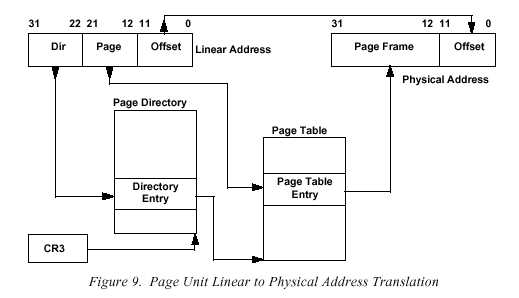
from Overview of the Protected Mode Operation of the Intel Architecture by Steve Gorman.
Suppose a program executes
where x is stored at address 0x345205A8 or binary 00110100010100100000010110101000.
| 27-bit tag | 32 bytes of data |
|---|---|
| 011101011101001000000100101 | 88 99 AA BB CC ... |
| 101101000101001000110101101 | 57 63 FF 00 CE ... |
| 001101000101001000000101101 | 00 00 00 00 FF ... |
| 110010101101001001011101101 | 44 65 61 6e 20 ... |
Most P6 caches are 4-way set associative.
| 9 bit set address |
Entry 1 | Entry 2 | ||
|---|---|---|---|---|
| 18 bit tag | 32 bytes of data | 18 bit tag | 32 bytes of data | |
| 000000000 | 011101011101001000 | 4A 61 6E 65 ... | 011001001101001000 | 74 20 00 00 ... |
| .... | ||||
| 000101101 | 001101000101001000 | 53 65 62 65 ... | 001111011101001000 | 63 63 61 20 ... |
| .... | ||||
| 110101101 | 101101000101001000 | 47 68 69 6C ... | 101110000101001000 | 6D 61 6E 20 ... |
| .... | ||||
| 111111111 | 110010101101001001 | 44 65 61 6e ... | 001000100101001001 | 20 00 00 00 ... |
Same idea as the L1 cache.
If address is not in any cache, go the RAM!
Many programs could be using the same address 345205A8.

from Overview of the Protected Mode Operation of the Intel Architecture by Steve
Gorman.
| Virtual address | ||
|---|---|---|
| Dir | Page | Offset |
| 0011010001 | 0100100000 | 010110101000 |
| 105 | 288 | 1448 |
Compute the page frame as CR3[105][288]
| Real address | |
|---|---|
| Frame | Offset |
| CR3[105][288] | 1448 |
| 00001010101010101010 | 010110101000 |
But if CR3[105][288] is "empty", the page must be read in from the disk. This should be an extremely rare occurence.
1 lookup in the page directory + 1 lookup in the page table + 1 access to RAM is two memory accesses too many.
| Translation Look aside Buffer TLB |
|
|---|---|
| page number | frame number |
| 00110111110100100011 | 00001011110101001100 |
| 00110100010010111000 | 00011110101000000000 |
| 00110100010100100000 | 00001010101010101010 |
| 00111101110100000110 | 00000000001111101010 |
Look up the page number in the TLB. If there, use it. If not there, go to the page tables and add new lookup into the TLB. Cache misses should be rare! Try the command vmstat on your favorite Unix computer.
| P6 TLB's | |
|---|---|
| Type | Entries |
| Data -- 4-kbyte pages | 64 |
| Instruction -- 4-kbyte pages | 32 |
| Data -- large pages | 8 |
| Instruction -- large pages | 2 |